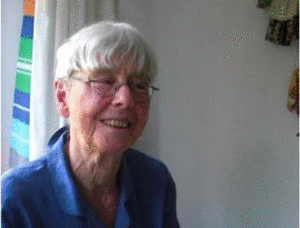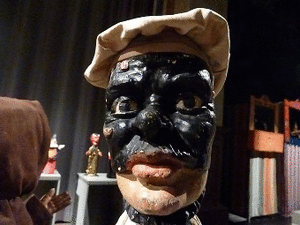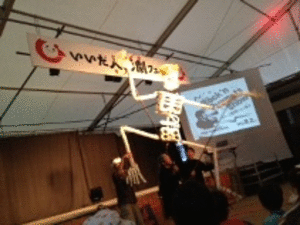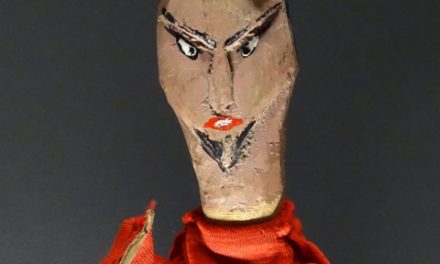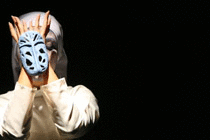On Monday 30 May 2016, Hetty Paërl – cheerful, versatile, driven and above all modest -, was awarded honorary membership of the UNIMA by the international UNIMA board: a good reason for an interview with this artist. Besides being an illustrator, painter and musician, she is also a writer of a great many books on puppetry. Her specialty is Jan Klaassen and his pedigree across Europe. The interview shows Hetty Paërl, born on 16 June 1931 in Wijhe, to be a woman who is fond of laughter, apparently sharing this art of living with Jan Klaassen’s British cousin, Punch: “That’s the way to do it”.
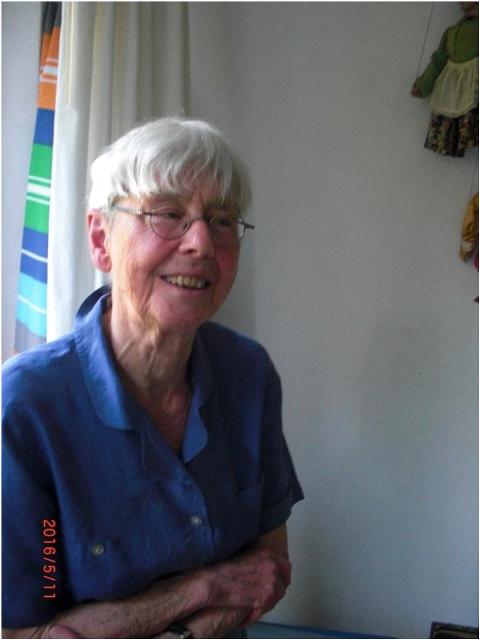
Hetty Paërl during the interview 11th of May 2016
A book on puppetry
‘I have so much for which to thank the UNIMA. Research into traditional folk puppetry brought me so much, starting with our own Jan Klaassen. From the very beginning, I have followed Wim Kerkhove, who saved the Jan Klaassen puppet play from demise and modernized it. I learned a great deal from him. Otto van der Mieden gave me great assignments and I was allowed to make ample use of his library. I have travelled throughout Europe, constantly meeting excellent puppeteers, who were warm, affectionate characters and passionately told me everything about their profession. They have invariably become true friends and referred me to other puppeteers, literature and museums on puppetry. In part, thanks to scholarships for research, I have been able to write books on puppetry.
After training at the Institute of Applied Art (the precursor of the Gerrit Rietveld Academy) in Amsterdam, I became a book illustrator. At Lankamp & Brinkman’s bookstore, I noticed a Pollock toy theatre in the window, and in the store you could buy paper models for this theatre. I set about designing a paper theatre myself, and showed it to my publisher with the proposal that I would make a book about it. The publisher wanted me to expand the design with hand puppets, marionettes and small rod puppets. But after I had finished it, I was told it was too much for his small publishing firm. He referred me to another publisher, who only wanted a book about shadow puppetry, with a part on history and a ‘do it yourself’ part. The book was published in 1979 and it is the only book that generated a good deal of money for me. It was translated into German and French, and it was published in paperback as well. The publisher later allowed me to make another book from the remaining material, published in1982.’
But what was the story with Jan Klaassen.
‘In the literature on European folk puppetry, I read that Jan Klaassen has roots in Italy. He originated from Pulcinella, and is the forerunner of many main comic characters from European folk puppet theatre. Pulcinella also has his forefathers – in Egypt, with the Romans. The figure of Pulcinella gradually spread across the whole of Europe from the beginning of the 17th century. Every country had its own version, such as Kašpárek in the Czech Republic, Kasperl in Germany, Polichinelle in France and Punch in Great Britain. Pulcinella’s suit was white and a black half-mask was painted on his puppet’s head. His European offspring all wore colourful costumes. I read that Pulcinella is a hermaphrodite, that his nose resembles a bird’s beak and that he has some other bird-like traits. Why? That is what I was eager to investigate.’
On the 325th birthday of Punch & Judy, the Italian Pulcinella puppeteer Bruno Leone played in London, alternating with Salvatore Gatto. Salvatore could play the guitar beautifully and sing just as well, and Bruno Leone danced in front of the cabinet in his white Pulcinella outfit with Pulcinella mask. Hetty started dancing along spontaneously. One thing led to another and Bruno invited her to come to Italy for three weeks to attend a six-day folk puppet theatre festival featuring rod puppets in Sicily, as well as the Pulcinella festival, which he organized in Naples. Pulcinella’s is very popular with locals in Naples. Hetty saw street rascals climbing high on the fencing in front of the windows of the theatre, which was filled to the rafters, hoping to be able to still catch a glimpse of the performance.
Preferably in English after all?
Bruno Leone trained as an architect, but actually wanted to become a puppeteer. He paid the last folk puppeteer, Nunzio Zambella, a visit, who didn’t want anything to do with him. Only after Bruno had learnt to speak with a self-made pivetta (in England: a ‘swazzle’. This is used for the Punch puppet when speaking – it is a metal and cotton tape reed) and after he had successfully given performances for young offenders in prison, did Zambella offer him his own swazzle and teach him the tricks of the trade. Bruno Leone collected a great deal of material and knowledge about the symbolic backgrounds to Pulcinella.
‘I subsequently went back to Naples ten times. My book on Pulcinella (2003) is a wonderful book, but it was not easy to sell it. After initially being published in Italian, the then Netherlands Theatre Institute was willing to publish the ready-made production with a great deal of visual material in Dutch. How I would love to have ‘Pulcinella, het mysterieuze spiegelbeeld van de mens’ [‘Pulcinella, the mysterious mirror image of man’] published in English after all. And also the book ‘Heerekrintjes – over Jan Klaassen en zijn buitenlandse soortgenoten’ (1987) [‘Heerekrintjes[1] – on Jan Klaassen and his foreign counterparts’], a summary of what authors from various countries have written on their own tradition of folk puppetry, complemented by personal observations of what remains of this now. Perhaps being awarded an honorary membership by the international UNIMA and the surrounding publicity may help in this matter.’
The language barrier broken
‘The world of puppetry is a wonderful world. Some puppeteers will receive you with open arms and let you in on all the secrets of the trade. This used to be less the case – there was more competition, and it was also for reasons of survival that not all cards were laid on the table just like that. The conferences I attended were usually about the history and significance of puppetry. After I had published the book on shadow puppetry, Felicia van Deth asked if I wanted to co-write the book ‘De Theaterpop’ (1981) [‘The Theatre Puppet’] with her. Then the NVP-UNIMA asked me if I wanted to write an overview that was published as ‘Ontwikkelingen in het Poppenspel in Nederland. Een overzicht van de jaren tussen 1945 en 1981 (1982) [‘Developments in Puppetry in the Netherlands. An overview of the years from 1945 to 1981’]. Afterwards, I found doors opened more easily for me.’
‘The strength of good puppeteers often lies in playing the characters convincingly. I watched famous Hungarian puppeteer Henrik Kemény play in London for an audience of children. He did it in Hungarian, his main puppet Vitez Laszo addressed the children in Hungarian, he asked them questions and the children responded in English. His acting was so suggestive it was mind-boggling. Folk puppet theatre has certain patterns. The humour, the interaction with the audience, the processing of current affairs, improvisation; these are all essential elements of folk puppetry.’
When the Berlin Wall was still there, folk puppeteers were given the cold shoulder in Czechoslovakia. Anton Anderle, who was from a family where the profession was passed on from generation to generation, had to call himself an amateur. He was not allowed to perform abroad. Hetty saw him perform in Prague, and she thought it was fabulous! When Hetty heard there would be an international folk puppet festival in Austria, she strongly recommended the organizer to invite Anderle. Anderle was then given permission by his government for the first time! Hetty attended his performance in Austria, and was given his main puppet Gasparko after the performance as a token of gratitude. A year later, Anderle also gave her the Zabinka: Gasparko’s wife. We were able to witness her fond cherishing of these beautiful puppets.
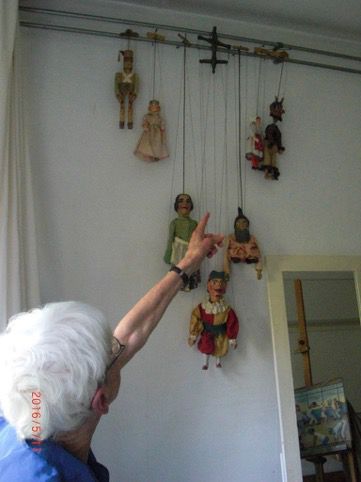
Hetty shows Anton Anderle’s Gasparko and Zabinka who hang on the wall in her house
That’s the way to do it!
‘During a symposium in Charleville Mézieres on traditional folk puppetry, a spirited discussion began on the underlying symbolism of the play-acting. The main character represents the common man, the other characters are parts of his ‘self’. These other parts of his character which are depicted as separate external beings have to be fought. The main character is played on the right hand, the opponents on the left hand. They appear one after the other. The main character, Jan Klaassen for us, confronts them; death, the general, the executioner, Katrijn (his wife): they are spin-offs of himself, with whom he engages in the battle of life: That’s the way to do it!’
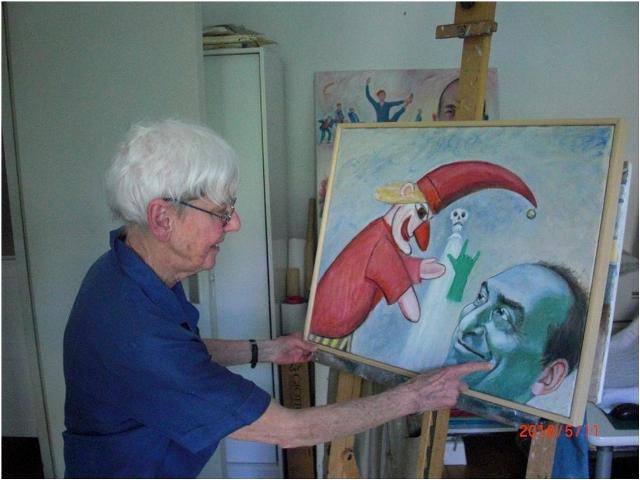
Painting by Hetty Paërl of Wim Kerkhove; puppeteer on the Dam from 1980 – 2000 and organiser of Puppet Theatre on the Dam, which can be watched every Sunday (since 2012). He is also the founder of the Jan Klaassen Academy.
It may be done in a more subtle, creative and sensitive manner
‘In my view tradition is paramount. You no longer need to introduce the main characters, nor the conflicts between them. The qualities have already been proven and you can build on what has been developed. The mouse is caught in the pan, or in your case, Frans, Katrijn catches the villain with a shopping trolley. Modern puppet theatre, which is often assimilated with – and merges with – many other theatre and art disciplines, is an interesting development. Modern art and theatre are known for continually pushing and breaking the boundaries. How will puppetry have developed in 20 years’ time? I truly do not know. You see waves in history all the time, and tradition, too, is not something that is etched in stone forever. A puppet has the ability to speak more easily, like the king’s court jester was the only one to offer him unreserved criticism. Puppet play is a proven means for criticizing social wrongs. The puppeteer can hide behind the puppet, and say: “they are not my words but those of the puppet”. I will always keep defending freedom of speech, but I have difficulty understanding why others have to be needlessly hurt nowadays.’
‘Of all main characters from European folk puppet theatre, Punch is the cruellest one. An English puppeteer told me once that Punch represents the hypocrisy of people. Punch shows how we cope with our feelings of discontent, frustration, disappointment and anger. He holds up a distorting mirror to us. Come on, away with that crying baby, out of the theatre with a great swing of Punch’s hand. ‘Paste them behind the wallpaper’, parents used to say when their children bothered them. There is a scene in which Punch takes the baby through the meat grinder; when he subsequently pulls the handle back, the baby appears again, this game is repeated several times. It is the children themselves who often have the most fun. It cannot be violent enough for them. It is play. It is often adults who worry about children’s souls. However, this is the wisdom of life, the art of life; as if everything is a bed of roses in real life. Are we allowed to let off steam for a moment while watching puppet theatre? I love it; it is a breath of fresh air. Last Sunday (Mother’s Day, 8 May) I went to watch Egon Adel from the Puppet Theatre on the Dam. But the fact remains that for some children it is not just a play sometimes, the puppets are real to them. You also notice this when they get to shake your hand after the Jan Klaassen performance.
Just look it up
Life, however serious and vulnerable, is a game. That’s the way to do it. Laugh about it.
‘Oh, all those names, I cannot remember them, I am really getting old, I think it is terrible’, Hetty cries out several times during our conversation. But she is still able to convey so much full of passion and fire. Most things are well-documented in her books, it is just a matter of looking it up. It is great what she achieved during her lifetime. She is rightly nominated for honorary membership of the international UNIMA.
Do you want to know more about Hetty Paërl?
Her entire oeuvre can be found in the library of the NVP-UNIMA. A great deal of her work can be read in the puppetry museum in Vorchten, such as an interview by Otto van der Mieden on her 80th birthday: ‘Handschriftelijk noteren’ [‘Noting down in handwriting’]. The document, which is available online, also contains a bibliography of her work. The puppetry museum also has a lot of Hetty Paërl’s visual work on display.
©Hetty Paerl, Paul Custers and Frans Hakkemars 20 May 2016
all photos made by Frans Hakkemars during the interview dd 11th of May 2016
website UNIMA Netherlands: www.nvp-unima.nl
website Otto van der Mieden’s Poppenspe(e)lmuseum in Vorchten: www.poppenspelmuseum.nl
website Wim Kerkhove’s Jan Klaassen Academie in Amsterdam: www.janklaassenacademie.nl
article published in WP Dutch magazine for puppetry 2016, number three, translated in English in response to Honorary UNIMA member Hetty Paërl, musician,painter, illustrator, researcher of traditional puppetry ….
[1] A Dutch expletive. A bastardised curse used by 19th century folk puppeteers when they performed for posh families and had to use decent language.

